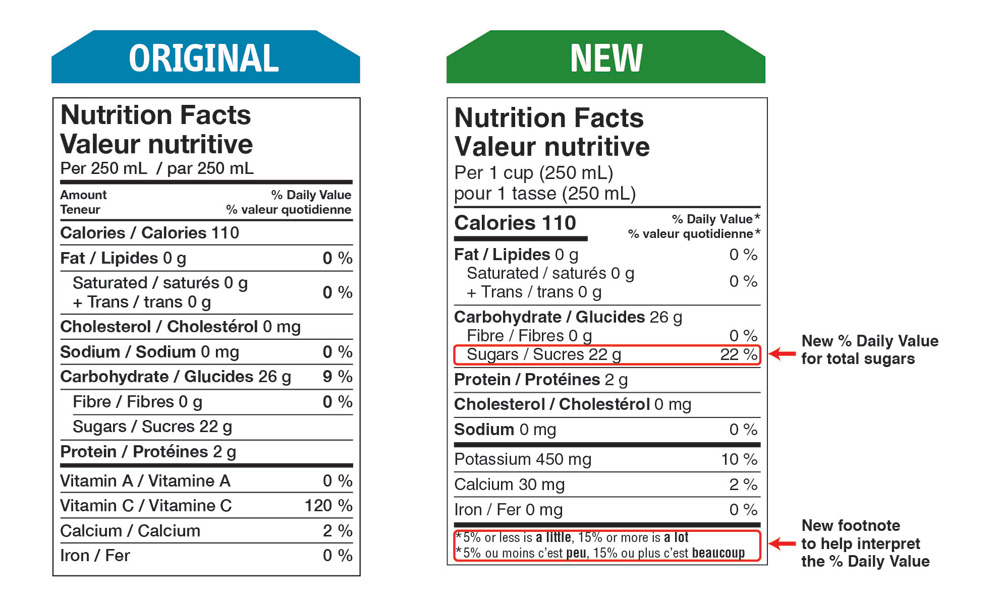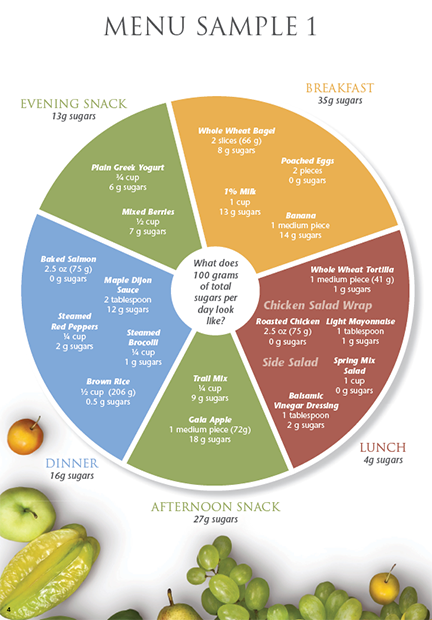Whats New
The Sweet Spot Challenge
Background on Sugars Labelling
Did you know? The Canadian government is making several important changes to the Nutrition Facts table and List of Ingredients on food labels that will appear on packaging over the next three years.
In fact, you may be seeing these new food labels appear on certain products right now! That's why we believe that it's important for Canadians to learn and understand what these changes mean.
A cornerstone of these changes to food labelling is providing additional information on sugars, including the addition of a Daily Value for total sugars in the Nutrition Facts table.
- Total sugars includes both sugars naturally occurring in fruits, vegetables, and milk products, as well as sugars that are added to foods (e.g. sugar, brown sugar, glucose-fructose (i.e. high fructose corn syrup), honey, maple syrup, concentrated fruit juice)
- The Daily Value of 100 grams total sugars is based on 20% of a 2,000 Calorie diet. According to Health Canada, "this value is not a recommended level of intake. Instead it is the amount of total sugars that is consistent with a healthy eating pattern".1 You do not need to aim to eat 100 grams of sugars per day!
- The % Daily Value for total sugars has been included to help consumers
- Compare the sugars content per serving of different foods, and
- Understand the relative amount of sugars in the context of total daily consumption.
1www.canada.ca/en/health-canada/services/nutrients/sugars.html

Enter the Sweet Spot Challenge!

We, the dietitians at the Canadian Sugar Institute, realize that introducing a Daily Value for sugars will impact the way consumers understand food labels and may introduce some confusion and questions. For example, can their favourite foods still fit?
That's why we're looking to you to find out what this new 100 g Daily Value for total sugars (both naturally occurring and added) looks like for Canadians, who all have different eating habits. The goal of the Sweet Spot Challenge is to provide a visual sample of what 100 grams of sugars per day can look like as part of a 2,000 Calorie meal plan.
Before you read on, remember: there is no single right way to execute this challenge. We encourage you to get creative, explore different possibilities and themes, and - most of all - have fun experimenting.
We look forward to seeing what you cook up!
Sweet Spot Challenge: Details
Your task is to create a one-day menu plan that incorporates the new 100 gram Daily Value for total sugars. Get as close as possible to 2,000 Calories recognizing that the Daily Value is based on 20% of a 2,000 Calorie diet. Include a variety of foods and beverages and be mindful of general recommendations to also limit sodium and saturated fats. Keep in mind that the Canadian Nutrient File will have Calorie and nutrient information, including total sugars, for most foods.
We ask that you take a balanced approach in generating a healthy meal plan that includes a reasonable balance of naturally occurring and added sugars while being easy, affordable, and delicious. Be sure to consider different consumers' dietary habits and lifestyles. For example, what might 100 g of sugars look like for a 9-5'er, a young athlete, an older adult, a foodie, a shift worker, or someone you interact with frequently in your day to day practice? If the total energy intake for this audience is higher or lower than 2,000 Calories per day, total sugars intake would make up about 20% of Calories. For example, for a 1,800 Calorie diet, total sugars intake would be 90 g, and for a 2,200 Calorie diet, it would be 110 g.
Please include in your submission:
- A breakdown of the ingredients and amounts used, as well as nutrition information derived from Canadian Nutrient File, using the provided Excel template
- Completed pie chart according to the provided template
Nutrition information can be obtained from the Canadian Nutrient File (we can help you complete this information if needed):
- Go to food-nutrition.canada.ca/cnf-fce/index-eng.jsp
- Enter each Food Name into the Search bar, choose the correct Food Code from the list that comes up, and the desired serving size, to display its nutrient profile.
- Mark down the "Sugars, total" gram amount that it generates as well as other nutrient information - Carbohydrates, Fibre, Total Fat, Saturated Fat, Sodium, Protein. Also keep track of the Energy (Calories) for each item as it will be important to see what the actual % of Calories are from sugars in your final menu plan.
- Continue on until you have determined the macronutrients content and Calories for al of the foods and beverages included in your one-day meal plan.
- Use the sum function built into the Excel spreadsheet to add it up to find out totals for your one-day meal plan!
- It might take some time, alterations, and/or experimentation with the foods selected to get the total to ~ 100 g sugars (+/- 5 g sugars is perfectly fine!) and ~ 2,000 Calories (+/- 100 Calories). We've included an Excel spreadsheet template to help you keep track of the foods and corresponding nutrition information, and easily allows you to sum the changing amounts together.
Final detail: The first 30 eligible submissions will receive a $25 grocery gift card and be compiled into an e-book. All submissions will also be included in a draw to win a $100 grocery gift card!
Need some inspiration?
Or, see what other dietitians have cooked up:
- Andy DeSantis (Toronto, ON)
- Doug Cook (Toronto, ON)
- Gloria Tsang (Vancouver, BC)
- Marianne Bloudoff (Victoria, BC)
- Susan Watson (Winnipeg, MB)
Download the full instruction booklet here.
For more information and to submit your one-day meal plan, contact:
Chiara DiAngelo, MPH, RD | Manager, Nutrition Communications
Telephone: 416-368-8091 ex 3
Email: cdiangelo@sugar.ca
Or visit: www.sugar.ca




